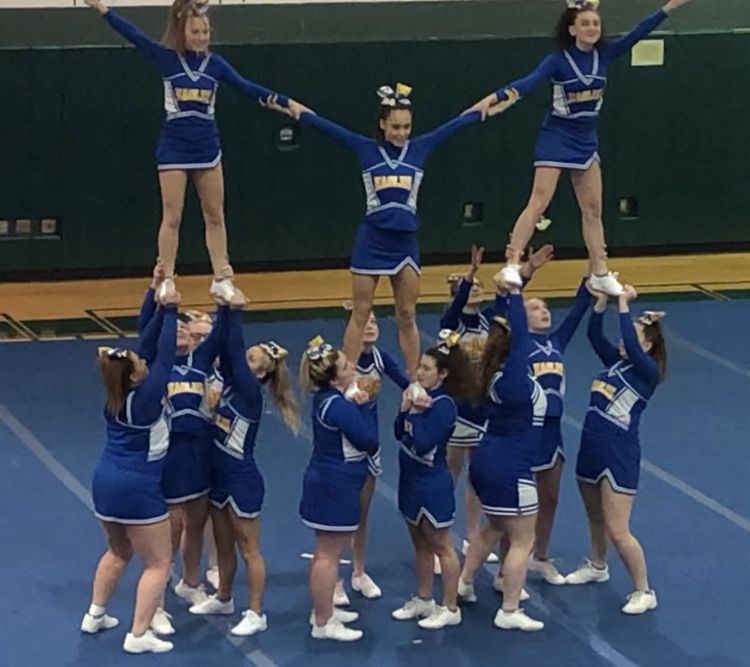Cheerleading Isn’t As Easy As You’d Think
When you think of cheerleading, what comes to mind? Many people would imagine the stereotypical, bubbly girl whose only priority is to yell “go team” from time to time and to do a few motions and dance a little on the floor. Well from personal experience, cheer isn’t as light and fluffy as it seems. It is filled to the brim with long hours, determination, frustration, sweat, and even occasionally blood and tears. There are around 50 sidelines you must memorize, the minimum of 5 cheers to learn, a dance or two, and how to stunt all before the first game, normally only a few days after tryouts, and competitions. We put in several hours a week, up to 15, to perfect ourselves to perform and excite the crowd.
Unlike many sports, members on the team have more of a responsibility to show up to practices, games, and competitions. This is because of formations, ripples, and stunting. You can’t easily replace a squad member as you would if you were to send out a basketball player onto the court if they couldn’t make it to a game. Missing one member of the squad causes the need to rearrange others so formations for performances are not off and motions don’t look uneven. However, the most difficult task is rearranging girls for stunting, or when we lift or are being lifted by others. This is because everyone has a specific job during stunting. These include flying, basing, or backspotting. For example, someone who normally flies can not just jump in as a backspot because they may not be tall enough for controlling the stunt group or they don’t know how to do the tasks at all. It is also difficult because if you don’t have someone to fill in for a stunting position the stunt doesn’t go up at all. Therefore, those girls will need to be placed somewhere else, often doing motions they haven’t learned right before a game, while other stunt groups are going up. Hence, we often show up for our team though we are injured or are sick. Last year, I showed up to the last game of the year despite having a 103.1 fever because I was front and center for many of the cheers, being the captain, and was one of the only experienced backspots on the team. I sat on the bleachers with a heavy winter coat during sidelines but ran out, yelled, stunted, and cheered during the timeouts and quarters. I know that many other girls on my squad have had similar experiences to prove our determination to support and be there for the team.
Another obstacle many cheerleaders face is unity, whether is be motinons on the floor or emotionally as a team. There is a lot of pressure to learn motions because they must be done on time and done the same way as everyone else or the performance won’t be together and will look messy. It is also an embarrassment if you do the wrong motion while everyone else is doing the right one because you will stand out in front of everyone. There is nothing more you can do besides continuing the routine with a smile on your face to avoid standing out even more, though that may be difficult. There must also be an emotional type of unity on the team, especially during stunting. If there is no trust or a special bond, the stunt will not be as strong, balanced, or won’t go at all. This is because the bases must watch each other and be simultaneous with movements to effectively put the flyer up and bring her down safely, everyone in the group must listen and trust the calls of what to do from the backspot, and the flyer must believe that if they fall everyone will catch them. I recall one experience my freshman year on the team. There was an argument and tenseness among teammates right before a large competition. Everyone was upset. When we were on the floor, almost all of the stunts either didn’t go up at all or fell due to the lack of support and trust. Yet, after many tears and hugs we were able to learn our lesson and unite. We were even able to perform the best we ever had that year during the next competition.
There is an overbearing risk when it comes to cheerleading as well. Multiple studies have found that the most dangerous contact sport in terms of injury isn’t football, wrestling, boxing, or soccer… it’s cheerleading. This is because of the very high risk for concussions and catastrophic injuries, which are those that result in long-term medical conditions, permanent disabilities or a shorter lifespan. More than one girl on my team has suffered from concussions from either being dropped or landed on. Once they are recovered, they are often too nervous to continue or don’t perform as confidently out of an understandable fear. I have had a close experience to a concussion as well. Last year, I was to do a handstand, lock legs onto my base, and be pulled up into a shoulder sit. It was a very basic stunt, but as I was setting myself up to fly, my base accidentally stumbled and fell off the mat with my feet still locked on her shoulders. If it wasn’t for my backspot, who dove to clutch my head, I would have smacked my head off of the hardwood cafeteria floor. After that, I have been fearful to fly even basic stunts. I can’t imagine how my other teammates who have actually suffered from concussion must have felt.
Pain constantly accompanies cheerleading, too. Every day seems to bring new sets of bruises, scratches, tears, and blood. This involves every single position in a stunt group, those who tumble, and everyone who jumps. During summer camp stunting, I had the job of backspotting for a new flyer. She went up perfectly fine, but when we bumped her down she fell backwards, placing all of her weight down on my face. This quick pressure caused me to go into an involuntary backbend, which threw my back out for the remainder of camp, and a blown up lip. I found myself lying on the turf with tears streaming out of my eyes and blood dripping from my mouth. Yet, I managed to get up and continue backspotting despite the immense pain. Another instance was when my friend suffered a black eye and a bloody nose, that gushed all over her white cheer shoes, after being stepped on by her flyer. But, she came back from the bathroom a minute later, still with dried tear marks on her cheeks, ready to step right back under the girl, who inadvertently used her as a stepping stool, with a positive attitude.
There is also a less injury-like pain when it comes to the hair and uniform aspect in cheerleading as well. We are often forced to perform and practice wearing a thermal long-sleeved bodysuit, tight bloomers, and a thick material skirt and shell. We are also used to wearing bulky cheer shoes that often give you blisters in the beginning, pinch your toes, and are always to be kept a pristine white. We lug all of our clothing, along with our poms and hair supplies, in a long duffle bag and keep our uniform in a bag to refrain from wrinkling it and getting it dirty. This is a pain when it comes to keeping track of your belongings, bringing everything to school, carrying everything on away games, and just being a heavy load to handle in general. Putting our hair up is a great struggle too. Our hair is to be in a tight and high ponytail, often with several clips and bobby pins, what seems like a pound of hairspray (to keep every flyaway back), painfully tight braids, as well as a large bow that feels almost impossible to place in our hair some days. One of the worst feelings is when we come home at night to tug out our bow and undo our hair, only to have it leaving your scalp sore and a great number of hair strands ripped out. I always like to joke that I lose half my head of hair during cheer season.
Overall, cheerleading isn’t as easy as many would like to believe. I take great pride in saying I am a cheerleader and wouldn’t change it out for another sport. My team has become a great supportive system and we have become so close that we are more of a family rather than a team. Despite the pain and all the effort it takes, I wouldn’t change all the long hours of practice, games, and competitions for anything because I believe everything is worth it. Next time when you think of cheerleading, I hope you think of everything it truly takes to be a cheerleader.

Ella is a fantastic writer and enjoys participating in cheer-leading and holds the position of class historian in class office.

